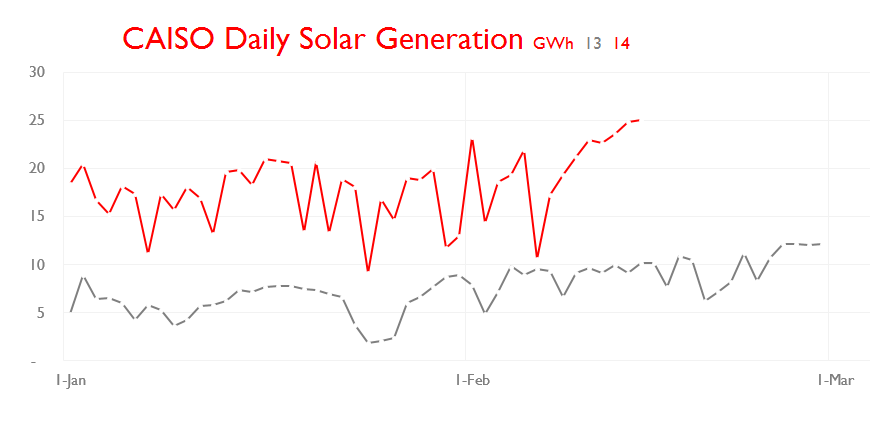Last week saw the commissioning of the large solar thermal plant at Ivanpah. It is about 400 MW capacity and should be visible in the daily solar output of California. Many other Solar PV projects have launched or expanded in the past year, making California the guinea pig in the grand renewables experiment.
A snapshot the daily solar output YOY in the California ISO so far this year:
This represents about 4% of the daily demand in the CAISO region right now. Normally that demand grows substantially with the onset of summer cooling requirements, but solar will increase even more, as the sun shines higher for longer and new capacity comes on line.
It is easy to look that the aggregate totals and say that solar still doesn't make a meaningful difference, but that is not a complete analysis. The load profile is very good and very predictable for solar in the summer out west. Yes clouds reduce output, but those are largely foreseeable and also reduce cooling demand in summer. The fact that solar has a peak shaving effect also complicates things for the grid and for complimentary fuels.
Look at yesterday's generation requirements (Fri Feb 14), and see the solar contribution:
Outside of summer, there is typically one obvious peak, around 7 pm in the evening. But a typical July day peaks in the late afternoon. Let's look back at Friday July 12 last year:
Here the peak is between 4 and 5 pm, and the longer day extends solar's contribution until almost 8 pm. This will reduce the need for some of the most expensive power in the US of A, peak summer California demand.
We also can't ignore two other trends where California may be the vanguard. The first is distributed solar, made up mainly of 'rooftop solar', which is penetrating the market out west rapidly, due to several factors already well known (sunny, subsidized, and 3rd party financed to name the biggest). This should be shaving grid demand along the same daily generation profile as the institutional solar measured above.
The second trend seems to be declining demand. California generation requirements so far this year have been consistently below 2013. Here's a broad brush look: Aggregate daily demand comparison.
Not only has it been below last year on all but 3 days this year so far, but the daily peak has followed a similar trend. That's important because the peak occurs after sunset, when solar (utility or distributed) is not a factor because output is at zero.




